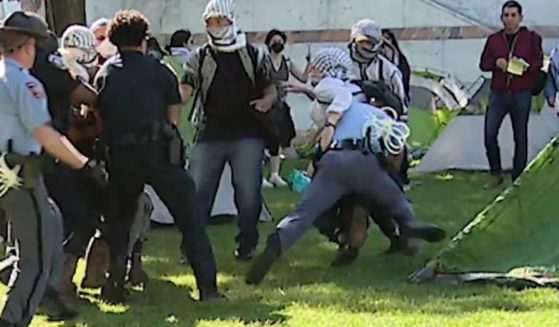Apparent Wave of Poisonings Rocks Dozens of Schools, At Least 400 Students Have Fallen Ill
A crisis over suspected poisonings targeting Iranian schoolgirls escalated Sunday as authorities acknowledged over 50 schools were struck in a wave of possible cases. The poisonings have spread further fear among parents as Iran has faced months of unrest.
It remains unclear who or what is responsible since the alleged poisonings began in November in the Shiite holy city of Qom. Reports now suggest schools across 21 of Iran’s 30 provinces have seen suspected cases, with girls’ schools the site of nearly all the incidents.
The attacks have raised fears that other girls could be poisoned, apparently just for going to school. Education for girls has never been challenged in the more than 40 years since the 1979 Islamic Revolution. Iran has been calling on the Taliban in neighboring Afghanistan to allow girls and women return to school and universities.
Interior Minister Ahmad Vahidi on Saturday said, without elaborating, that investigators recovered “suspicious samples” in the course of their investigations into the incidents, according to the state-run IRNA news agency. He called for calm among the public, while also accusing the “enemy’s media terrorism” of inciting more panic over the alleged poisonings.
However, it wasn’t until the poisonings received international media attention that hard-line President Ebrahim Raisi announced an investigation into the incidents on Wednesday.
Vahidi said at least 52 schools had been affected by suspected poisonings. Iranian media reports have put the number of schools at over 60. At least one boy’s school reportedly has been affected.
Videos of upset parents and schoolgirls in emergency rooms with IVs in their arms have flooded social media. Making sense of the crisis remains challenging, given that nearly 100 journalists have been detained by Iran since the start of protests in September over the death of 22-year-old Mahsa Amini. She had been detained by the country’s morality police and later died.
The security force crackdown on those protests has seen at least 530 people killed and 19,700 others detained, according to Human Rights Activists in Iran.
The children affected in the poisonings reportedly complained of headaches, heart palpitations, feeling lethargic or otherwise unable to move. Some described smelling tangerines, chlorine or cleaning agents.
Reports suggest at least 400 schoolchildren have fallen ill since November. Vahidi, the interior minister, said in his statement that two girls remain in hospital because of underlying chronic conditions.
As more attacks were reported Sunday, videos were posted on social media showing children complaining about pain in the legs and abdomen and dizziness. State media have mainly referred to these as “hysteric reactions.”
Since the outbreak, no one was reported in critical condition and there have been no reports of fatalities.
Attacks on women have happened in the past in Iran, most recently with a wave of acid attacks in 2014 around the city of Isfahan, at the time believed to have been carried out by hard-liners targeting women for how they dressed.
Speculation in Iran’s tightly controlled state media has focused on the possibility of exile groups or foreign powers being behind the poisonings. That was also repeatedly alleged during the recent protests without evidence. In recent days, Germany’s foreign minister, a White House official and others have called on Iran to do more to protect schoolgirls — a concern Iran’s Foreign Ministry has dismissed as “crocodile tears.”
However, the U.S. Commission on International Religious Freedom noted that Iran has “continued to tolerate attacks against women and girls for months” amid the recent protests.
“These poisonings are occurring in an environment where Iranian officials have impunity for the harassment, assault, rape, torture and execution of women peacefully asserting their freedom of religion or belief,” Sharon Kleinbaum of the commission said in a statement.
Suspicion in Iran has fallen on possible hard-liners for carrying out the suspected poisonings. Iranian journalists, including Jamileh Kadivar, a prominent former reformist lawmaker at Tehran’s Ettelaat newspaper, have cited a supposed communique from a group calling itself Fidayeen Velayat that purportedly said that girls’ education “is considered forbidden” and threatened to “spread the poisoning of girls throughout Iran” if girls’ schools remain open.
Iranian officials have not acknowledged any group called Fidayeen Velayat, which roughly translates to English as “Devotees of the Guardianship.” However, Kadivar’s mention of the threat in print comes as she remains influential within Iranian politics and has ties to its theocratic ruling class. The head of the Ettelaat newspaper also is appointed by Supreme Leader Ayatollah Ali Khamenei.
Kadivar wrote Saturday that another possibility is “mass hysteria.” There have been previous cases of this over the last decades, most recently in Afghanistan from 2009 through 2012. Then, the World Health Organization wrote about so-called “mass psychogenic illnesses” affecting hundreds of girls in schools across the country.
“Reports of stench smells preceding the appearance of symptoms have given credit to the theory of mass poisoning,” WHO wrote at the time. “However, investigations into the causes of these outbreaks have yielded no such evidence so far.”
Iran has not acknowledged asking the world health body for assistance in its investigation. WHO did not immediately respond to a request for comment Sunday.
However, Kadivar also noted that hard-liners in Iranian governments in the past carried out so-called “chain murders” of activists and others in the 1990s. She also referenced the killings by Islamic vigilantes in 2002 in the city of Kerman, when one victim was stoned to death and others were tied up and thrown into a swimming pool, where they drowned. She described those vigilantes as being members of the Basij, an all-volunteer force in Iran’s paramilitary Revolutionary Guard.
“The common denominator of all of them is their extreme thinking, intellectual stagnation and rigid religious view that allowed them to have committed such violent actions,” Kadivar wrote.
The Western Journal has reviewed this Associated Press story and may have altered it prior to publication to ensure that it meets our editorial standards.
Truth and Accuracy
We are committed to truth and accuracy in all of our journalism. Read our editorial standards.












